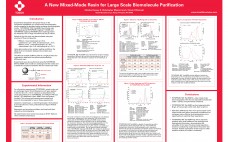Endotoxin or lipopolysaccharides (LPS) are highly toxic components of the cell wall of Gram-negative bacteria and are often present in significant amounts in bacterial cell culture expression systems such as E. coli. A number of methods have been adopted for the removal of endotoxin based on adsorption, in particular ion-exchange chromatography. Although downstream processing can significantly reduce endotoxin levels in the product, efficient and cost-effective removal of residual endotoxin from biopharmaceutical preparations remains a challenge. This technical poster addresses the…
Downstream Processing
Sartopore (R) Platinum Sterile Filtration, Redefined
We introduce a new class of Sterile Filtration for Biopharmaceutical industry with Sartopore® Platinum. It offers exceptional total throughput, thanks to its patent-pending TwinPleat technology with 1 m2 area/10” element. At the heart of Sartopore® Platinum are PES membranes permanently hydrophilized with proprietary grafting of thermally stable polymer on to membrane surfaces. This leads to minimal wetting requirements prior to Integrity testing with < 5 L./10” preflush needed in < 1 min. They also offer low Protein Binding and low…
A New Mixed-Mode Resin for Large Scale Biomolecule Purification
Chromatographic resins with high capacities and selectivities differing from those seen with traditional hydrophobic interaction and ion exchange media are now in demand. Mixed-mode chromatography media is an alternative. Some mixed-mode resins combine both traditional hydrophobic interaction and ion exchange media. This poster introduces TOYOPEARL® MX-Trp-650M, a high-capacity weak cation mixed-mode resin for the purification of biomolecules. The polymethacrylic base bead was chemically modified with the amino acid tryptophan which combines a weak cationic group with a hydrophobic functional group.…
Toward Nonantibody Platforms
Monoclonal antibodies (MAbs) remain the largest segment of the biopharmaceutical market, but they are not the only recombinant proteins in development. Remember that the first biopharmaceutical approved for sale was recombinant insulin — a hormone — back in the 1980s. And proteins aren’t the only recombinant biologics. The sector has expanded since then to include gene therapies and viral vectors, vaccines, and even cells and tissues. Companies around the world are developing such products for cancer, neurological, infectious disease, metabolic,…
Integrity Testing of Ultrafiltration Systems for Biopharmaceutical Applications
Ultrafiltration (UF) is a membrane-based separation technology commonly used in the biopharmaceutical industry for concentration or diafiltration of protein solutions to remove low–molecular-weight (LMW) impurities or exchange buffers. The nominal MW limit of UF membranes ranges from 1,000 Da (1 kDa) to 1,000,000 Da (1,000 kDa). A target product is retained by the membrane while lower-MW solutes or impurities pass through (1). For a target product with a smaller MW than the impurities, separation is accomplished by allowing…
New Downstream Harvest Options Using Custom Designed Disposable Resins
Engineered affinity resins create the ability to produce functional proteins on a solid support in vivo which can lower production costs, improve flexibility and increase scale up speed.
Next Generation PEGylation Technology
Decreases in the immunoreactivity of next generation PEGylated drugs may be attainable by the use of monofunctionally activated hydroxyPEGs instead of methoxyPEGs in their synthesis.
Single-Use Depth Filtration for Mammalian Cell Culture Clarification
Clarifying cell culture broth is the first downstream unit operation in an elaborate sequence of steps required to purify a biological therapeutic. A combination of centrifugation, depth filtration, or tangential-flow filtration (TFF) is used for that operation. The availability of large-scale, single-use, depth filtration technology in the recent years, however, has given process developers the capability to improve and simplify downstream processes.
New Technology for Broad Screening of Cell Microbial Contaminants, Including Viruses
Two case studies are presented highlighting the impact PLEX-ID System can have to rapidly identify virus contaminants resulting in better control of biologics manufacturing process, with the potential to characterize various sources of excursion through genotyping information.
A Decade of Harvesting Methods
The preliminary separation of a protein of interest from a reactor “soup” of process impurities (e.g., cell debris, colloids, lipids) is the first step in a downstream process. It is also a primary step that introduces a significant risk of product degradation, bioburden concerns, or process errors, especially if a harvest method is not a good “fit” with a newly designed bioreactor (e.g., single-use) or fermentation vessel. In 2003, BPI’s first year, industry concerns revolved around potential capacity…






